IK Multimedia IRIG-KEYS-I/O-49 Users Manual
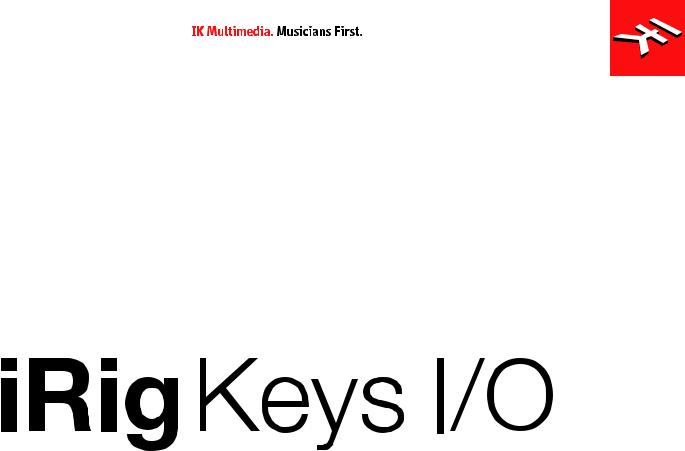
The all-in-one music production station that goes anywhere you want.
USER MANUAL

Contents
Table of Contents
Contents |
2 |
|||
English |
6 |
|||
|
Power adapter information |
6 |
||
|
iRig Keys I/O |
6 |
||
|
Register your iRig Keys I/O |
6 |
||
|
1 Installation and setup |
7 |
||
|
|
1.1 iOS Devices |
7 |
|
|
1.2 |
MAC/PC |
12 |
|
|
2 MIDI controller section |
13 |
||
|
2.1 |
Keyboard |
13 |
|
|
2.2 |
Drumpads |
13 |
|
2.3 |
Touch sensitive controls |
13 |
||
|
|
2.3.1 iRig Keys I/O 49 |
13 |
|
|
|
2.3.2 iRig Keys I/O 25 |
15 |
|
|
2.4 |
Knobs |
15 |
|
|
3 Presets |
16 |
||
|
3.1 |
Preset recall |
16 |
|
|
3.2 |
Rapid user preset recall |
16 |
|
|
3.3 |
Preset store |
17 |
|
|
3.4 |
User presets delete |
17 |
|
|
4 Factory default settings |
18 |
||
|
4.1 |
Global settings |
18 |
|
4.2 |
Factory 1 - IK Virtual Instruments |
18 |
||
|
|
4.2.1 iRig Keys I/O integration with IK Virtual Instruments |
19 |
|
|
4.3 |
Factory 2 - Apple Logic Pro X/GarageBand |
21 |
|
|
4.4 |
Factory 3 - Chromatic PADS + MIDI Volume and MIDI Pan |
22 |
|
|
4.5 |
Factory 4 - Program Change PADS + MIDI Volume and MIDI Pan |
23 |
|
|
5 Edit Mode |
24 |
||
|
5.1 Audio output volume |
24 |
||
|
5.2 Global edit menu |
24 |
||
|
|
5.2.1 Send specific MIDI Program Changes numbers, and set Current Program number |
25 |
|
|
|
5.2.2 Keyboard edit |
25 |
|
|
|
5.2.2.1 Set the MIDI Transmit Channel of the keyboard |
26 |
|
|
|
5.2.2.2 Set different velocity (touch) response to the keyboard |
26 |
|
|
|
5.2.2.3 Transpose the keyboard in semitones |
27 |
|
|
|
5.2.3 Enable/disable touch knob features |
28 |
|
|
|
5.2.4 Send “All Notes Off” MIDI message |
29 |
|
|
|
5.2.5 Reset iRig Keys I/O |
29 |
|
2

Contents
5.3 Preset edit menu |
30 |
|
|
5.3.1 DATA Knob |
30 |
|
5.3.1.1 Edit the DATA knob |
30 |
|
5.3.2 Knob edit |
31 |
|
5.3.3 External pedal edit |
32 |
|
5.3.3.1 Assign CC to the expression pedal |
32 |
|
5.3.3.2 Assign CC to the Sustain pedal |
32 |
|
5.3.3.3 Assign PC to the Sustain pedal |
33 |
|
5.3.4 Pads edit |
34 |
|
5.3.4.1 Set the MIDI Transmit Channel |
34 |
|
5.3.4.2 Set different velocity (touch) response |
35 |
|
5.3.4.3 Single Pad editing |
35 |
|
5.3.5 Slider edit |
37 |
|
5.3.5.1 Assign a Pitch bend command to a slider |
37 |
|
5.3.5.2 Assign a Mod wheel command to a slider |
38 |
|
5.3.5.3 Assign a CC message to a slider |
39 |
|
5.3.6 Slider editing on iRig Keys I/O 25 |
40 |
|
5.3.6.1 Assign a Pitch bend command to a slider |
40 |
|
5.3.6.2 Assign a Mod wheel command to a slider |
41 |
|
5.3.6.3 Assign a CC message to a slider |
41 |
|
5.3.6.4 Assign the Octave control to a slider |
42 |
|
5.3.6.5 Assign the Program Change control to a slider |
43 |
|
5.3.7 Transport edit |
44 |
6 Low Battery |
44 |
|
Troubleshooting |
44 |
|
Specifications |
45 |
|
Warranty |
46 |
|
Support and more info |
46 |
|
iRigKeys I/O - iRig Keys I/O
1.1iOS
1.2macOS/Windows PC
2MIDI
2.3.1 iRig Keys I/O 49 2.3.2 iRig Keys I/O 25
47
47
47
47
48
48
53
54
54
54
54
54
56
3

Contents
2.4
4.2Factory 1 - IK 4.2.1 IK
4.3Factory 2 - Apple Logic Pro X/GarageBand
4.4Factory 3 - MIDI
4.5Factory 4 - MIDI
5
5.1
5.2
5.2.1 MIDI 5.2.2
5.2.2.1 MIDI
5.2.2.2 5.2.2.3 5.2.3
5.2.4 MIDI“ ”
5.2.5 iRig Keys I/O
5.3
5.3.1 DATA
5.3.1.1 DATA 5.3.2 1~8
5.3.3
5.3.3.1 CC 5.3.3.2 CC
5.3.3.3
5.3.4
5.3.4.1 MIDI
5.3.4.2 5.3.4.3 5.3.5 5.3.5.1
5.3.5.2
5.3.5.3 CC
5.3.6 iRig Keys I/O 25
5.3.6.1 5.3.6.2
5.3.6.3 CC
5.3.6.4
56
57
57
57
58
58
59
59
59
60
62
63
64
65
65
65
66
66
67
67
68
68
69
70
70
70
71
72
72
73
73
74
74
74
75
75
77
77
78
78
79
79
80
80
81
4

Contents
|
|
|
5.3.6.5 |
82 |
6 |
5.3.7 |
83 |
||
|
83 |
|||
|
|
|
83 |
|
|
|
|
84 |
|
|
|
|
85 |
|
|
|
|
85 |
|
Regulatory |
86 |
|||
5
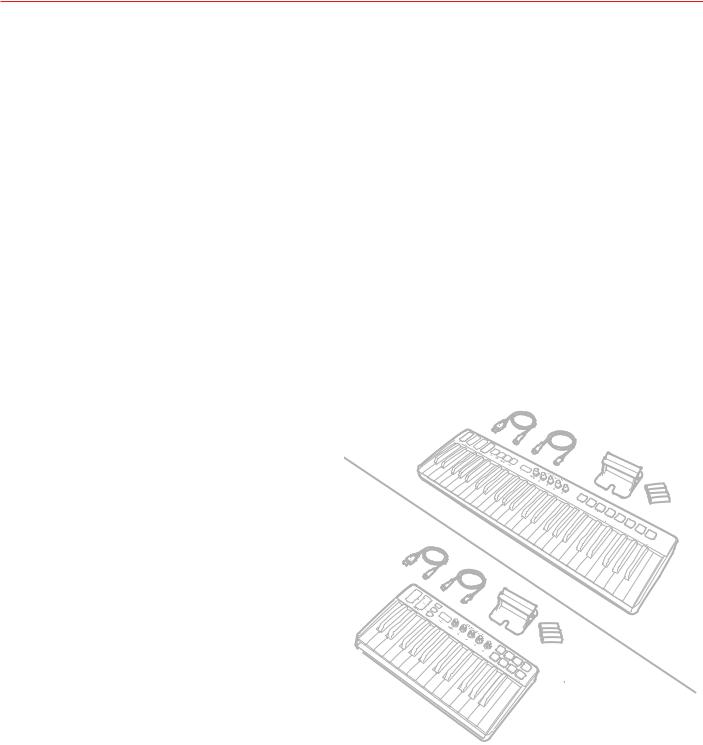
English
Power adapter information
Use only the specified AC adaptor you can buy at: www.ikmultimedia.com/irigpsu3a
Use only the specified AC adaptor (iRig PSU 3A) and make sure the line voltage at the installation matches the input voltage specified on the AC adaptor’s body.
IK Multimedia will not be responsible of any damage caused by usage of any AC adaptor other than the specified one (iRig PSU 3A).
The usage of AC adaptors other than the specified one (iRig PSU 3A) could compromise the user experience in terms of:
•Safety risk
•Apple device charging performances
•Noise performances
iRig Keys I/O
Thank you for purchasing iRig Keys I/O. Your package contains:
•iRig Keys I/O (25 or 49)
•Lightning Cable
•USB Cable
•4AA batteries
•Tablet support
•Quick Start Guide
•Registration Card
Register your iRig Keys I/O
1x |
iRig Keys I/O 49 |
|
1x |
|
1x |
1x |
|
1x |
1x |
|
|
|
1x |
1x
iRig Keys I/O 25
By registering, you can access technical support, activate your warranty and receive free JamPoints™ which will be added to your account. JamPoints™ allow you to obtain discounts on future IK purchases! Registering also keeps you informed of all the latest software updates and IK products.
Register at: www.ikmultimedia.com/registration
6
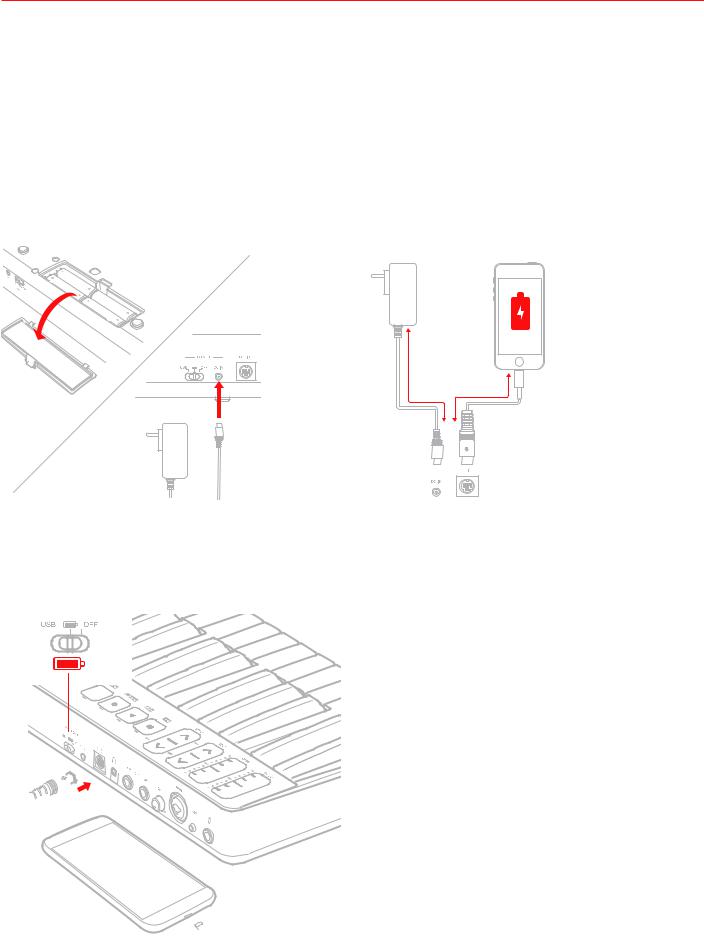
English
1 Installation and setup
iRig Keys I/O can be USB bus powered, powered by internal AA batteries or external PSU (not included).
iOS: when connected to an iOS Device either esternal PSU or batteries are needed. The external PSU (not included) will charge the iOS Device’s battery. When both batteries and PSU are connected, all the power will be supplied by the PSU.
USB: typically, when connected to an USB host (MAC, Windows or Android), all the needed power is provided by the host. If the connected host is not capable to provide the required power either batteries or PSU may be needed.
IMPORTANT: if the power switch is set to  and batteries are present, the keyboard will be powered by the batteries even when connected to a USB host that can provide enough power.
and batteries are present, the keyboard will be powered by the batteries even when connected to a USB host that can provide enough power.
4 x AA
1.1 iOS Devices
1.Connect the Mini-DIN to Lightning cable to the iRig Keys I/O port and to the iOS device port.
2.Move the back side switch to the battery position (both if you are using batteries or the external PSU).

 1
1
2
 7
7
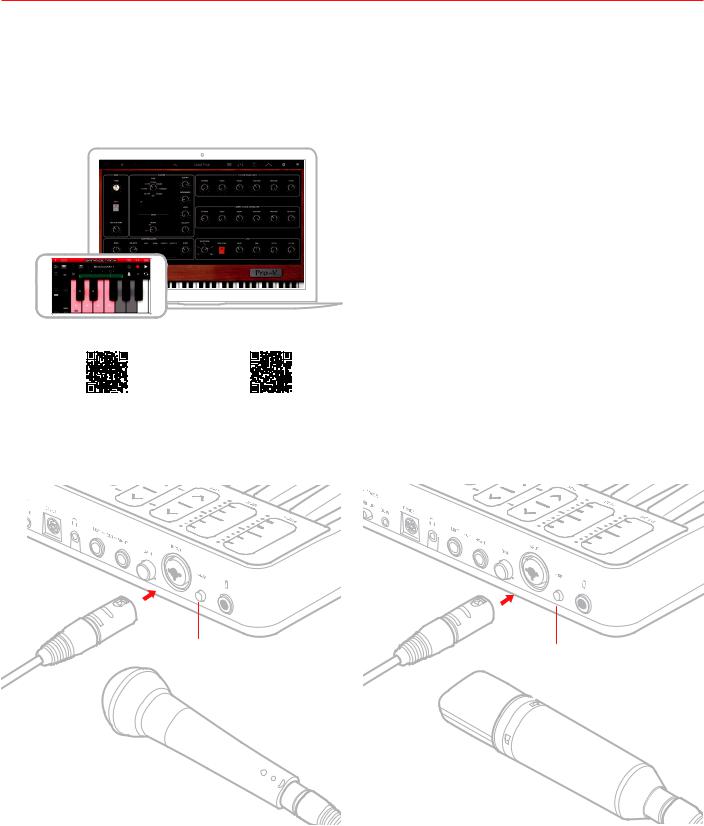
English
3. Download and launch your favourite APP
SampleTank 3, Miroslav Philharmonik 2 CE*,
Syntronik Pro-V for iOS/Mac/PC, and T-RackS Deluxe,
Ableton® Live 9 Lite, PreSonus® Studio One Prime for Mac/
PC
FREE DOWNLOAD
ikdownloads.com/irigkeysio25 ikdownloads.com/irigkeysio49
*iRig Keys I/O 49 only
4.Connect a microphone or an instrument to the input combo jack. If the microphone you are using requires external phantom power, activate the 48V switch.
XLR |
XLR |
|
|
1 |
2 |
48V OFF |
|
|
|
48V ON |
8
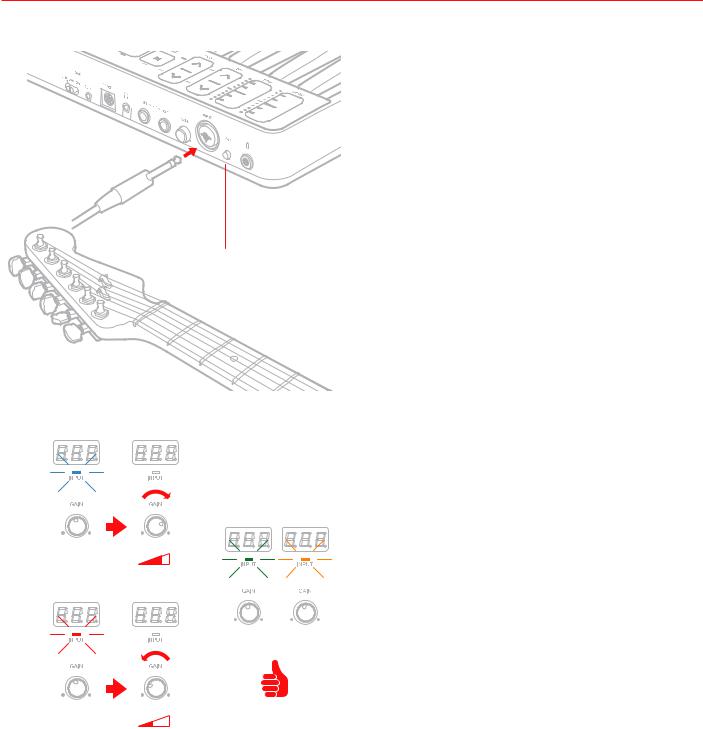
English
 1/4"
1/4"
48V OFF
5. Adjust the input level with the gain potentiometer.
BLUE
GREEN / ORANGE
RED
9
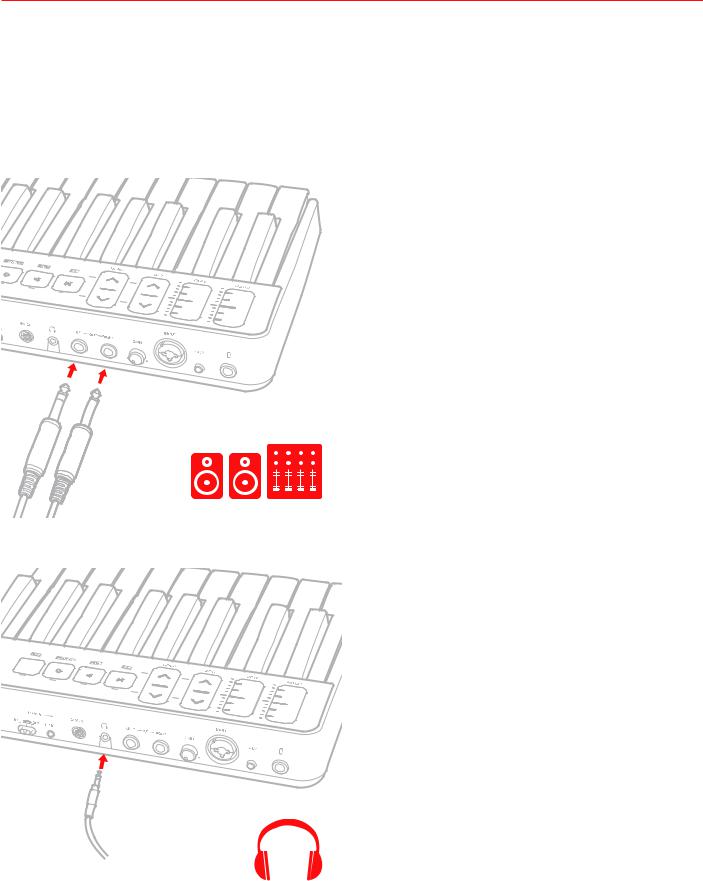
English
6.Connect a mixer, an amplifier or a PA system to the stereo line outputs. It is possible to control the output volume with the DATA/VOLUME knob on the top panel (please refer to the instruction on this manual). These are floating balanced output. This kind of output approximately simulates a floating transformer winding;
if both hot and cold outputs are driving signal lines, then the outputs are balanced, as if a centretapped output transformer were being used. This system has the advantage that it can give the same level into either a balanced or unbalanced input without rewiring connectors. These kind of outputs are also perfect to route the onstage signal to a mixer without the need of a DI box, ensuring a loud and pristine signal.
 1/4"
1/4"
7.Connect your headphones to the headphone output. It is possible to control the output volume with the DATA/VOLUME knob on the top panel (please refer to the instruction on this manual).
10
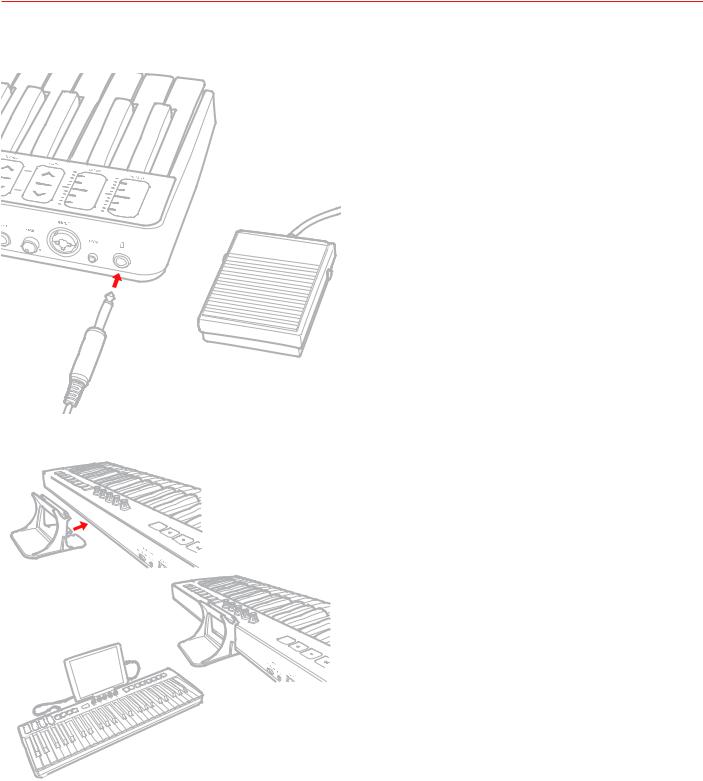
English
8. If needed, connect a footswitch/expression pedal to the TRS connector on iRig Keys I/O.
9. Fix the tablet holder for a perfect view.
11
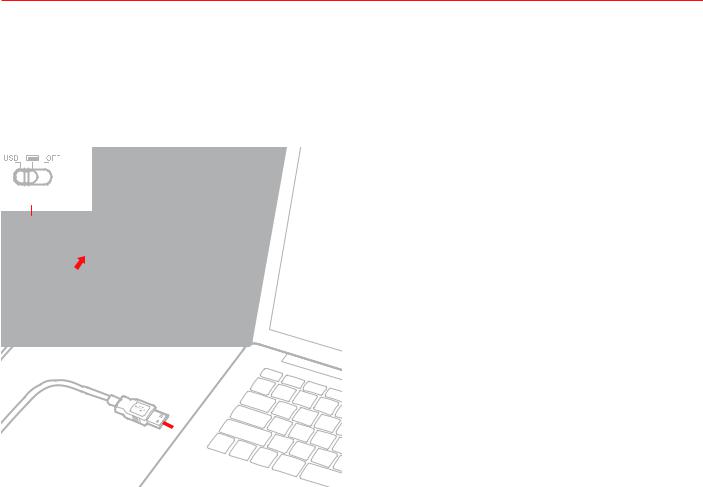
English
1.2 MAC/PC
1.Connect the Mini-DIN to USB cable to the iRig Keys I/O port and to a free USB port on your MAC/PC (the required power is supplied by the USB host).
2.Move the back side switch to the USB position.
USB
 1
1
2
3.Download and launch your favourite Software.
4.Connect a microphone or an instrument to the input combo jack. If the microphone you are using requires external phantom power, activate the 48V switch. Adjust the input level with the gain potentiometer.
5.Connect a mixer, an amplifier or a PA system to the stereo line outputs. It is possible to control the output volume with the DATA/VOLUME knob on the top panel (please refer to the instruction on this manual).
6.Connect your headphones to the headphone output. It is possible to control the output volume with the DATA/VOLUME knob on the top panel (please refer to the instruction on this manual).
7.If needed, connect a footswitch/expression pedal to the TRS connector on iRig Keys I/O.
8.Fix the tablet holder for a perfect view.
12

English
2 MIDI controller section
2.1 Keyboard
iRig Keys IO 25 by default plays notes between C2 and C4. iRig Keys IO 49 by default plays notes between C1 and C5.
If you need to play notes lower or higher than this range, you can shift the whole keyboard in octaves using the OCT up and down buttons.
2.2 Drumpads
iRig Keys I/O 25 has 8 drum pads, in 2x4 disposition. iRig Keys I/O 49 has 8 drum pads, in 1x8 disposition.
All the 8 pads on iRig Keys I/O can send MIDI Note ON and OFF, MIDI CH and MIDI CC messages. On each pad it’s possible to program what kind of message will be sent (Note, CC or MIDI CH). Each pad is illuminated by a RGB LED and the illumination gives you feedback on the pad status.
2.3 Touch sensitive controls
2.3.1 iRig Keys I/O 49
PITCH BEND
Slide this touch sensitive sensor up or down to send Pitch Bend messages. When you don’t touch the sensor, it return to a central rest position. Moving the finger up will increase the pitch; moving it down will decrease the pitch.
Note that the amount of pitch change depends on how the receiving virtual instrument is set. This control can be edited to send any other CC message (see dedicated chapter on this manual).
MODULATION WHEEL
Slide this touch sensitive sensor to send Modulation Wheel messages (MIDI CC#01). The lowest position
13
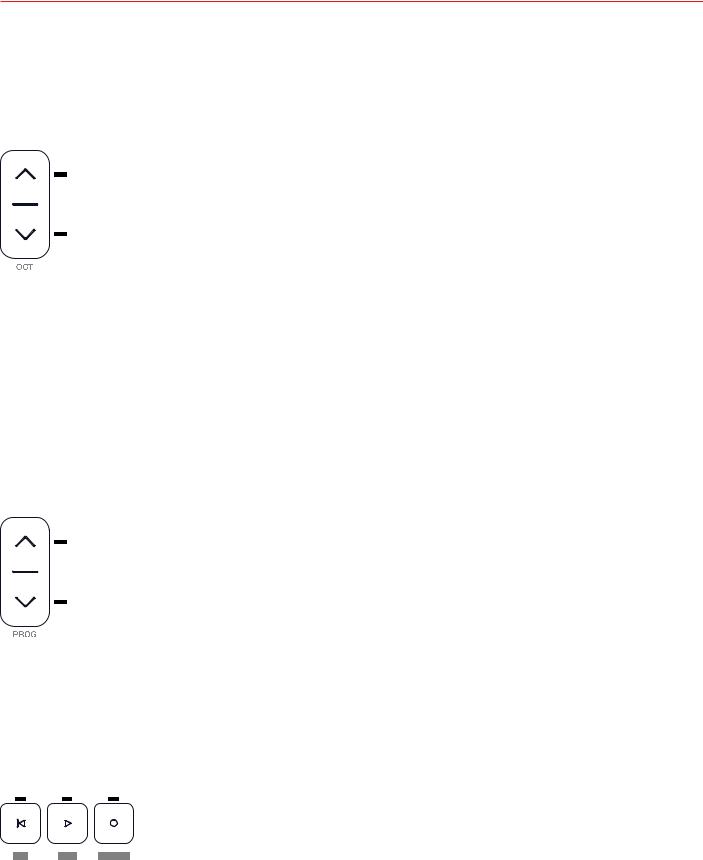
English
sends a value of 0; the highest position sends a value of 127. Most instruments use this message to control the amount of vibrato or tremolo in the sound, but note that this depends solely on how the receiving instrument itself is programmed and not on the iRig Keys I/O settings. This control can be edited to send any other CC message (see dedicated chapter on this chapter).
OCTAVE SHIFT
iRig Keys I/O 49 by default plays notes between C1 and C5.
If you need to play notes lower or higher than this range, you can shift the whole keyboard in octaves using the OCT up and down buttons.
You can shift a maximum of 4 octaves up or 4 octaves down. The OCT buttons LEDs will flash each time you press them. The number of times they flash corresponds to the number of octaves up or down the keyboard is shifted.
The displays will inform you about the octave shift indicating a number relative to the octaves that has been shifted. For example going from 0 to +1 the display will show “ 1” and will remain visible until another action on the keyboard is performed. Negative shifts will be shown as “ -1”.
PROGRAM CHANGES
Sound modules like virtual instrument apps or plug-ins can switch sounds when they receive the Program Change MIDI message. iRig Keys I/O sends Program Changes by pressing the PROG up or down buttons.
Starting with the currently selected program, iRig Keys I/O will send the next higher program numbers when you press PROG UP and lower program numbers when you press PROG DOWN. The 7-segment displays will inform you about the number relative to the PC number that has been selected. To set the current program see the dedicated chapter on this manual.
TRANSPORT BUTTONS and ALT BUTTON
These touch-sensitive buttons serves as transport controls, from left to right: Stop/Return-to-Start/FFW (when ALT button is active), Play and REC. The far right button, labeled as ALT, serves to enable/disable the alternative
14

English
functions of buttons and knobs.
When the ALT button is active thetransport buttons above will turn in (from left to right): Fast forward (FFW), EDIT, PRESET.
EDIT Mode and PRESET Mode functionality will be described later on this manual.
IMPORTANT: configure the transport in the Preset menu so it communicates properly with your software.
2.3.2 iRig Keys I/O 25
MODULATION WHEEL/ PITCH BEND
As primary function this slider act as a Pitch Bend control. By pressing the ALT button, it will switch to Modulation Whell control.
The operational mode can be edited from hold-mode to return-to-zero mode (see dedicated chapter on this manual). This control can be edited to send any other CC message (see dedicated chapter on this chapter).
PROGRAM CHANGES/OCTAVE SHIFT
As primary function this cotrol act as Octave control. By pressing the ALT button, it will switch to PROG change control.
The operational mode can be edited from hold-mode to return-to-zero mode (see dedicated chapter on this chapter). This control can be edited to send any other CC message (see dedicated chapter on this chapter).
2.4 Knobs
The DATA knob act as browsing control when used in specific software or can be used to send a generic CC number programmable by the user. It acts also to control the audio output volume when the ALT function is active. Refer to the dedicated section on this manual for complete editing instructions.
The Knobs 1 to 8 can be assigned to any Control change number. When the ALT function is active the knobs from 5 to 8 are activeted. Refer to the dedicated section on this manual for complete editing instructions. These knobs are also touch sensitive: this means that you’ll be able to see the current value of the CC assigned to each knob by simply touching it. The touch feature allows you, also, to send a specific CC# (momentary and freely assignable, as described later in this manual) when the knob is touched: it is also possible to disable these functions as described later in this manual.
The knobs can have different behaviour (Relative or Absolute):
When working in Absolute (ABS) mode the knob will send values from 0 to 127 on the selected CC (+1 increments per clockwise encoder steps and -1 decrements per counter-clockwise encoder steps).
Once values 0 or 127 are reached they will be continued to be sent if the knob is rotated in the same direction.
The starting value from which to send +1 or -1 values will always be the last one sent by the knob the last time it was moved.
When working in Relative (REL) mode the knob will send custom values to the selected CC. This will allow the host application to browse long lists of elements easily.
15

English
3 Presets
iRig Keys I/O comes with 4 factory presets (F01...F04) and 99 user presets (U01...U99) freely assignable. The keyaboard can be configurated per personal use: it is possible to configure knobs, pads, touch sliders and external pedal and all these configurations can be stored, recalled (via RCL or fast-recall) as user presets; the factory presets can be only recalled.
To enter to the Presets menu, press the ALT button and then the PRESET button:
The display will shows RCL (recall preset) and all the drum pads corresponding to non empty user presets from U01 to U08 will light on (this will allows you for a rapid recall of the preset).
As said, the display will shows RCL and by rotating the DATA knob it will cycle between STR (store user preset) and DEL (delete user presets). The press on the DATA knob will select the action.
3.1 Preset recall
•Enter Preset Mode by pressing the ALT and PRESET buttons;
•If a user preset has been previously stored in the first 8 positions, the corresponding pad will light on. This allows you for a rapid user preset recall (refer to point 1.2 of this manual). If you’d prefer to recall a preset in the standard way, proceed with the following steps;
•The display will show RCL (recall). Press the DATA push-knob to confirm you want to recall a preset;
•The display will show F01 (factory preset 1). By rotating the DATA knob it will cycle between the factory presets (F01 to F04) and, eventually, stored user presets.
•Reached the desired preset push the DATA push-knob to confirm the action.
•The keyboard will exit automatically the Preset Mode. You can exit the preset mode any time by pressing the CANCEL/NO key.
3.2 Rapid user preset recall
The fast-recall feature allows you to recall a user preset directly with the 8 drum-pads: this is usefull in live setup or where an immediate preset recall is needed.
You can perform a rapid user preset with the drum pads.
•Enter Preset Mode by pressing the ALT and PRESET buttons;
•All the 8 drum pads corresponding to non empty user presets from U01 to U08 will light on;
•Press the drum pad corresponding to the user preset previously stored;
•The keyboard will exit automatically the Preset Mode. You can exit the preset mode any time by pressing the CANCEL/NO key.
16
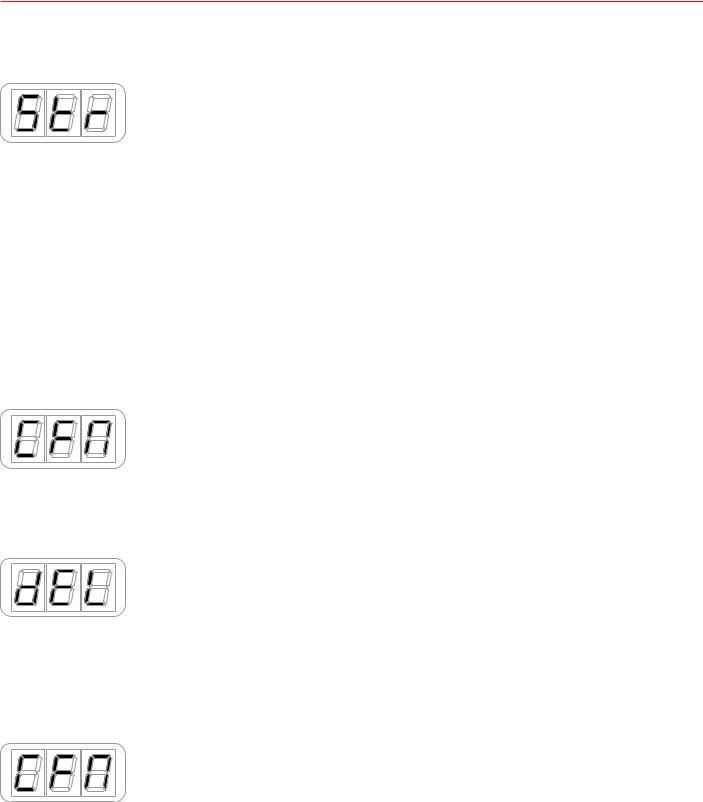
English
3.3 Preset store
•Enter Preset Mode by pressing the ALT and PRESET buttons;
•The display will show RCL. By rotating the DATA knob it will cycle between STR (store preset) and DEL (delete presets). Reached the STR position press the DATA push-knob to confirm you want to store a preset;
•The display will show U01 (User preset 1). By rotating the DATA knob it will cycle between the user presets (U01 to U99);
•Reached the position you want to store the preset on, press the DATA push-knob;
•If the location is empty, the preset will be directly stored on that position and the keyboard will exit automatically the Preset Mode.
•If the location had a previously stored preset a further confirmation step will be needed to confirm to overwrite the previous preset. At the press of the DATA push-knob the display will show CFM (confirm) to confirm that you want to overwrite the previous preset. To confirm this action press the DATA knob, the preset will be stored and the keyboard will exit automatically the Preset Mode.
•You can exit the preset mode any time by pressing the CANCEL/NO key.
3.4 User presets delete
•Enter Preset Mode by pressing the ALT and PRESET buttons;
•The display will show RCL. By rotating the DATA knob it will cycle between STR (store preset) and DEL (delete presets). Reached the DEL postition press the DATA push-knob;
•The keyboard will request you to confirm if you want to delete all the user presets previously stored, by showing CFM;
•By pressing the DATA push-knob all the previously store user presets will be deleted and the keyboard will exit automatically the Preset Mode;
•You can exit the preset mode any time by pressing the CANCEL/NO key.
17

English
4 Factory default settings
4.1 Global settings
Audio Volume : 50
Program Change: 0
Keyboard MIDI CH: 1 Keyboard Velocity: 2 (Normal) Keyboard Transpose: C
Knobs Touch : ON (Sensing) - OFF (Control Change)
4.2 Factory 1 - IK Virtual Instruments
Generic DAW remote with Absolute knobs
DATA knob -> CC#22 Relative mode (ALT -> audio output volume)
DATA push -> CC#23
Slider 1 -> Pitch Bend / iRig Keys I/O 25 Slider 1-> Pitch Bend (ALT -> Mod Wheel) Slider 2 -> Mod Wheel / iRig Keys I/O 25 Slider 2-> Octave (ALT -> Prog Change) Exp Pedal -> Expression CC#11
Sus Pedal -> Sustain CC#64 Momentary action
Pad 1 -> C1
Pad 2-> D1
Pad 3 -> E1
Pad 4 -> F#1
Pad 5 -> A#1
Pad 6 -> G1
Pad 7 -> B1
Pad 8 -> C#2
Pad MIDI CH -> Key Pad Velocity -> 2 (Normal)
Knob 1 -> CC#12 Absolute mode (Touch CC#30 - OFF by default) Knob 2 -> CC#13 Absolute mode (Touch CC#31 - OFF by default) Knob 3 -> CC#14 Absolute mode (Touch CC#32 - OFF by default) Knob 4 -> CC#15 Absolute mode (Touch CC#33 - OFF by default) Knob 5 -> CC#16 Absolute mode (Touch CC#34 - OFF by default) Knob 6 -> CC#17 Absolute mode (Touch CC#35 - OFF by default) Knob 7 -> CC#18 Absolute mode (Touch CC#36 - OFF by default) Knob 8 -> CC#19 Absolute mode (Touch CC#37 - OFF by default)
Transport -> MMC
18
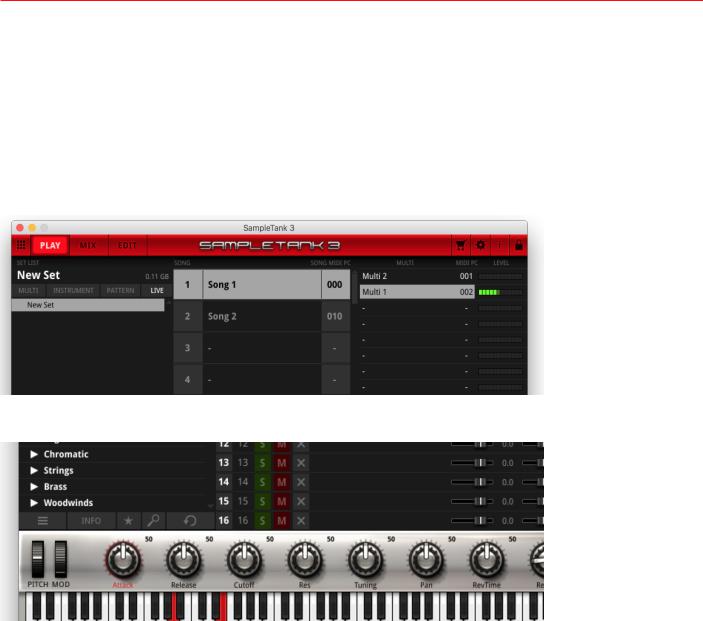
English
4.2.1 iRig Keys I/O integration with IK Virtual Instruments
SampleTank 3 and Miroslav Philharmonik 2
1.Launch SampleTank 3;
2.Rotate the DATA knob and scroll between the folders of the SampleTank 3 library;
3.Press the DATA knob to disclose a folder and load an instrument;
4.Press PROG up and down buttons to browse and load SampleTank 3 Multis according to the current Live Set preset loaded on SampleTank 3;
5.Rotate knobs 1 to 4 on iRig Keys I/O to control the first four macros of SampleTank 3. If the Touch CC is enabled, as soon as you touch a knob this will highlight on the user interface;
6.To access knobs 5 to 8 on your iRig Keys I/O, press the ALT button on the left side of the display, then rotate, so you can control the remaining next four macros of SampleTnak 3;
19
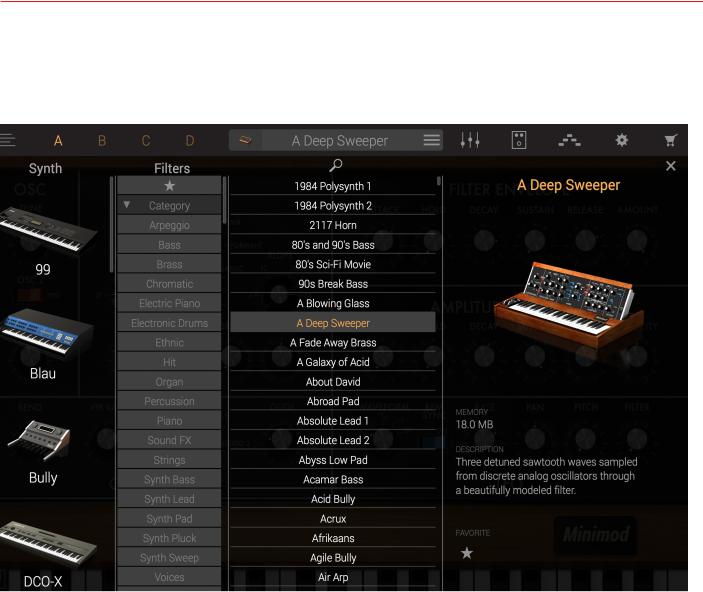
English
Syntronik
1.Launch Syntronik;
2.Rotate the DATA knob and scroll between the presets of Syntronik;
3.Press the DATA knob to load the selected preset;
4.iRig Keys I/O knobs can be easily assigned to any parameter of Syntronik with the MIDI learn function.
20

English
4.3 Factory 2 - Apple Logic Pro X/GarageBand
Generic DAW remote with Relative knobs
DATA knob -> CC#22 Relative mode (ALT -> audio output volume)
DATA push -> CC#23
Slider 1 -> Pitch Bend / iRig Keys I/O 25 Slider 1-> Pitch Bend (ALT -> Mod Wheel) Slider 2 -> Mod Wheel / iRig Keys I/O 25 Slider 2-> Octave (ALT -> Prog Change) Exp Pedal -> Expression CC#11
Sus Pedal -> Sustain CC#64 Momentary action
Pad 1 -> C1
Pad 2-> D1
Pad 3 -> E1
Pad 4 -> F#1
Pad 5 -> A#1
Pad 6 -> G1
Pad 7 -> B1
Pad 8 -> C#2
Pad MIDI CH -> Key Pad Velocity -> 2 (Normal)
Knob 1 -> CC#12 Relative mode (Touch CC#30 - OFF by default) Knob 2 -> CC#13 Relative mode (Touch CC#31 - OFF by default) Knob 3 -> CC#14 Relative mode (Touch CC#32 - OFF by default) Knob 4 -> CC#15 Relative mode (Touch CC#33 - OFF by default) Knob 5 -> CC#16 Relative mode (Touch CC#34 - OFF by default) Knob 6 -> CC#17 Relative mode (Touch CC#35 - OFF by default) Knob 7 -> CC#18 Relative mode (Touch CC#36 - OFF by default) Knob 8 -> CC#19 Relative mode (Touch CC#37 - OFF by default)
Transport -> CC
21

English
4.4 Factory 3 - Chromatic PADS + MIDI Volume and MIDI Pan
DATA knob -> CC#22 REL (ALT -> audio output volume)
DATA push -> CC#23
Slider 1 -> Pitch Bend / iRig Keys I/O 25 Slider 1-> Pitch Bend (ALT -> Mod Wheel) Slider 2 -> Mod Wheel / iRig Keys I/O 25 Slider 2-> Octave (ALT -> Prog Change) Exp Pedal -> Expression CC#11
Sus Pedal -> Sustain CC#64 Momentary action
Pad 1 -> C3
Pad 2-> C#3
Pad 3 -> D3
Pad 4 -> D#3
Pad 5 -> E3
Pad 6 -> F3
Pad 7 -> F#3
Pad 8 -> G3
Pad MIDI CH -> Key Pad Velocity -> 2 (Normal)
Knob 1 -> CC#07 Absolute mode (Touch CC#30 - OFF by default) Knob 2 -> CC#10 Absolute mode (Touch CC#31 - OFF by default) Knob 3 -> CC#11 Absolute mode (Touch CC#32 - OFF by default) Knob 4 -> CC#12 Absolute mode (Touch CC#33 - OFF by default) Knob 5 -> CC#13 Absolute mode (Touch CC#34 - OFF by default) Knob 6 -> CC#14 Absolute mode (Touch CC#35 - OFF by default) Knob 7 -> CC#15 Absolute mode (Touch CC#36 - OFF by default) Knob 8 -> CC#16 Absolute mode (Touch CC#37 - OFF by default)
Transport -> MMC
22

English
4.5 Factory 4 - Program Change PADS + MIDI Volume and MIDI Pan
DATA knob -> CC#22 Relative mode (ALT -> audio output volume)
DATA push -> CC#23
Slider 1 -> Pitch Bend / iRig Keys I/O 25 Slider 1-> Pitch Bend (ALT/ Mod Wheel) Slider 2 -> Mod Wheel / iRig Keys I/O 25 Slider 2-> Octave (ALT/ Prog Change) Exp Pedal -> Expression CC#11
Sus Pedal -> Sustain CC#64 MOM Pad 1 -> PC000
Pad 2 -> PC001
Pad 3 -> PC002
Pad 4 -> PC003
Pad 5 -> PC004
Pad 6 -> PC005
Pad 7 -> PC006
Pad 8 -> PC007
Pad MIDI CH -> Key
Pad Velocity -> 6 (Fixed 127)
Knob 1 -> CC#07 Absolute mode (Touch CC#30 - OFF by default) Knob 2 -> CC#10 Absolute mode (Touch CC#31 - OFF by default) Knob 3 -> CC#11 Absolute mode (Touch CC#32 - OFF by default) Knob 4 -> CC#12 Absolute mode (Touch CC#33 - OFF by default) Knob 5 -> CC#13 Absolute mode (Touch CC#34 - OFF by default) Knob 6 -> CC#14 Absolute mode (Touch CC#35 - OFF by default) Knob 7 -> CC#15 Absolute mode (Touch CC#36 - OFF by default) Knob 8 -> CC#16 Absolute mode (Touch CC#37 - OFF by default)
Transport -> MMC
23
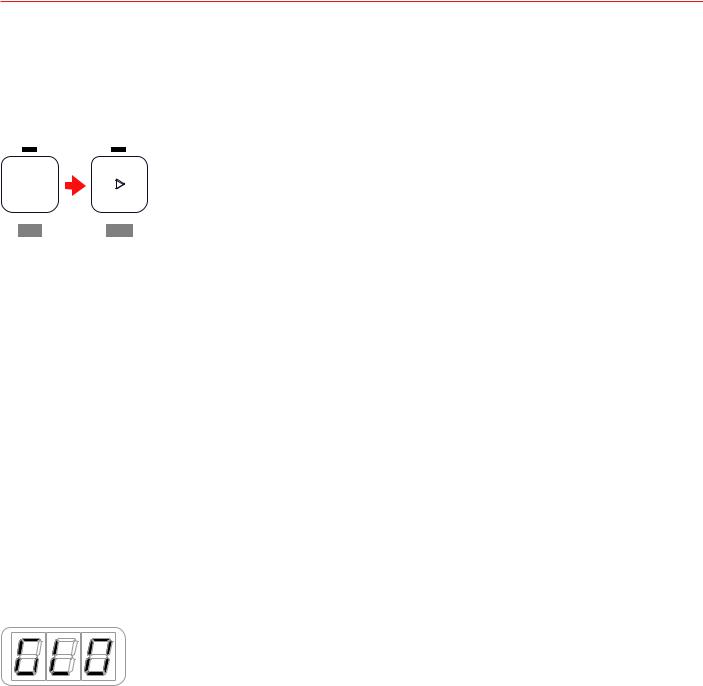
English
5 Edit Mode
In Edit Mode you can edit parameters related to the keyboard, pads, touch controls, knobs and perform a factory reset.
To enter to the Edit Mode, press the ALT button and then the EDIT button:
The display will shows GLO (global menu) to edit the global parameters and, by rotating the DATA knob, PRE (preset menu) to edit the parameters associated to the preset. It is possible to select global or preset by rotating the DATA knob: the confirmation of each action is provided by pushing the DATA knob.
In GLO (global menu) you will find: PC (program change) - KEY (keyboard) - TCH (touch knobs) - OFF (all-notes- off) - RST (factory reset)
In PRE (preset menu) you will find: DTA (DATA knob) - ENC (knobs) - PED (external pedal) - PAD (drum pads) - SLD (sliders) - TRN (transport).
5.1 Audio output volume
By default the audio output volume is set as ALT function of the DATA knob, so to adjust the audio output volume press the ALT button and rotate the DATA knob. The audio volume can be assigned as primary or ALT function by the user. Please refer to the dedicated section on this manual.
5.2 Global edit menu
24
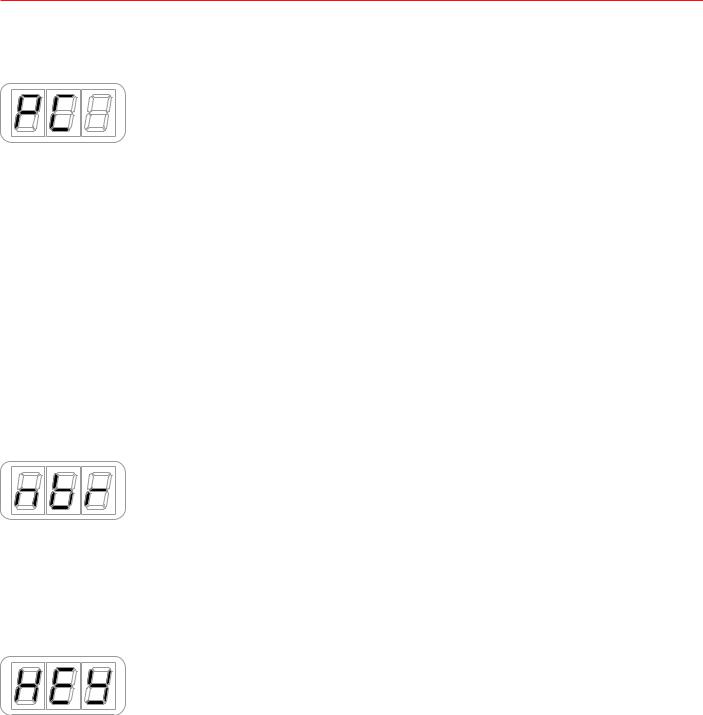
English
5.2.1 Send specific MIDI Program Changes numbers, and set Current Program number
iRig Keys I/O can send MIDI Program Changes in two ways:
1.Program Changes are sent sequentially by using the PROG up and PROG down buttons.
2.Program Changes are sent directly by sending a specific Program Change number from within EDIT mode. After sending a specific Program Change number, the PROG up and down buttons will work sequentially from that point.
To send a specific Program Change number:
•Enter Edit Mode by pressing the ALT and EDIT buttons;
•The display will show GLO. Press the DATA push-knob to confirm you want to edit a parameter in the global menu;
•By rotating the DATA knob it will cycle between the parameters of the Global menu;
•Reached the PC (programm change) position pess the DATA push-knob to confirm you want to set a Programm change;
•The display will show NBR (number) to let you insert the PC number. Insert the PC number (from 0 to 127) with the keys marked from 0 to 9. You can cancel your input with the CANCEL/NO key;
•To confirm your input press the DATA push-knob;
•The keyboard will exit automatically the Edit Mode;
•You can exit the Edit mode any time by pressing the CANCEL/NO key.
5.2.2 Keyboard edit
•Enter Edit Mode by pressing the ALT and EDIT buttons;
•The display will show GLO. Press the DATA push-knob to confirm you want to edit a parameter in the global menu;
•By rotating the DATA knob you will cycle between the parameters of the Global menu;
•Reached the KEY position pess the DATA push-knob to confirm you want to edit the keyaboard parameters;
•The display will shows CH (MIDI channel) and by rotating the DATA knob it will cycle between VEL (velocity) -> TRS (transpose).
25

English
5.2.2.1 Set the MIDI Transmit Channel of the keyboard
MIDI instruments can respond to 16 different MIDI channels. For iRig Keys I/O to play an instrument, you need the iRig Keys I/O MIDI Transmit Channel to match the receiving channel of your instrument.
To set the MIDI Transmit Channel:
•Enter Edit Mode by pressing the ALT and EDIT buttons;
•The display will show GLO. Press the DATA push-knob to confirm you want to edit a parameter in the global menu;
•By rotating the DATA knob you will cycle between the parameters of the Global menu
•Reached the KEY position pess the DATA push-knob to confirm you want to edit the keyaboard parameters;
•The display will shows CH (MIDI channel).
•Press the DATA puch-knob to confirm you want to set a MIDI channel;
•The display will show the current MIDI channel number;
•By rotating the DATA knob you can select the MIDI channel numer from 1 to 16;
•To confirm your input press the DATA push-knob;
•The keyboard will exit automatically the Edit Mode;
•You can exit the Edit mode any time by pressing the CANCEL/NO key.
5.2.2.2 Set different velocity (touch) response to the keyboard
The keyboard on iRig Kyes I/O is velocity sensitive. Usually this means that the harder you hit the keys, the louder the sound that is produced. However this ultimately depends on how the instrument you’re controlling is programmed and your playing style.
In order to match the style of individual users, iRig Keys I/O offers six different velocity response settings:
1.VEL SENS, LIGHT. Use this setting if you prefer a light touch on the keys. This is especially useful when you need to play fast passages or program drum patterns.
2.VEL SENS, NORMAL. This setting is the default setting and works well in most cases.
3.VEL SENS, HEAVY. Use this setting if you prefer a heavy touch on the keys.
4.FIXED, 64. This setting will always send a fixed MIDI velocity value of 64 without any touch response.
5.FIXED, 100. This setting will always send a fixed MIDI velocity value of 100 without any touch response.
6.FIXED, 127. This setting will always send a fixed MIDI velocity value of 127 without any touch response. To set the velocity response:
• Enter Edit Mode by pressing the ALT and EDIT buttons;
26
